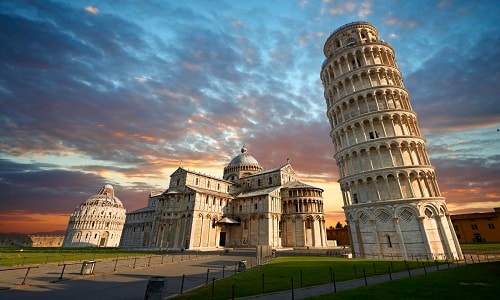The reason why the tower of Pisa leans
The Leaning Tower of Pisa, the world's most famous leaning structure, is the result of carelessness and poor planning by its engineers.
 |
| The Leaning Tower of Pisa is the most famous leaning structure in the world. Photo: meros. |
According to Ancient Origins, the Tower of Pisa was designed as a bell tower next to the Pisa Cathedral, in the Piazza del Miracoli (Square of Miracles). This structure was part of a construction project in Piazza del Miracoli, Pisa, Italy. In addition to the bell tower and the cathedral, the engineers also planned to build a baptistery and cemetery.
The Tower of Pisa was the third structure to be built in this project, but it was the last to be completed. Construction began in 1173. The architects were Bonanno Pisano and Gherardo di Gherardo. By 1178, three of the tower's eight stories were complete. But after the third story was completed, the tower began to lean to the north.
One reason for the tower's tilt is the geography of the city of Pisa itself. The city's name, which dates back to 600 BC, comes from the Greek word for "marshy land." The soft ground, which is mainly composed of mud, sand, and clay, is believed to be the culprit behind the tilt.
Several other buildings in Pisa also lean due to being built on soft ground, including the 12th-century church of San Nicola to the south of the leaning tower and the church of San Michele degli Scalzi to the east of the tower.
In addition, the foundation of the tower was made of a dense clay mixture and was about three meters deep. This foundation was not strong and deep enough to support the weight of the entire tower. These two factors combined led to the leaning of the Tower of Pisa.
The builders noticed the leaning of the tower, but there was nothing they could do to stop it. They raised the pillars and dome on the leaning side so they could continue building to the fourth floor. However, construction stopped for nearly a century because Pisa was constantly at war with other cities.
In 1272, the work continued under the direction of Giovanni di Simone. However, the war between Pisa and Genoa in 1284 stopped the construction of the tower. At that time, three more floors were added. This changed the center of gravity of the tower, causing the tower to lean in the opposite direction. In 1319, the construction of the seventh floor, which houses the bells, began. This is also the highest floor of the tower and was completed in 1372.
Initially, the lean of the Tower of Pisa was only 0.2 degrees. Over the centuries, this figure reached 5.5 degrees in 1990. The difference in plane between the top and the bottom of the tower is 4.6 meters. Therefore, in the following years, a project was implemented to stabilize the tower.
The ground beneath the tower was leveled and anchors were installed. The tower became more stable, but it continued to lean. This was not the first time authorities had tried to stop the tower's tilt. In 1934, dictator Mussolini had tried to do just that, but the effort backfired and increased the tilt.
In 2008, a second attempt straightened the tower 48 cm. This was the first time the tower had stopped shifting in 800 years. Experts estimate that the Leaning Tower of Pisa will stabilize for at least another 200 years.
According to VnExpress
| RELATED NEWS |
|---|

.png)






